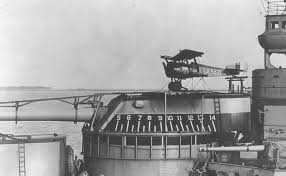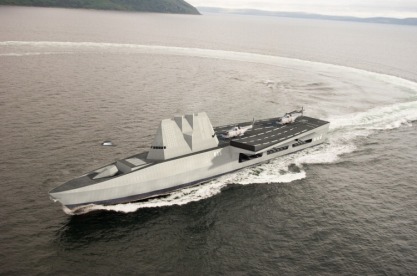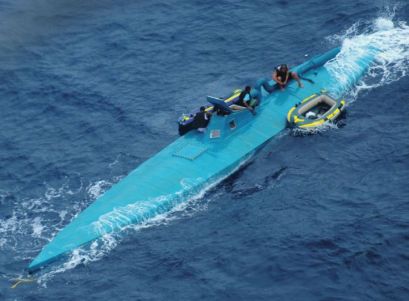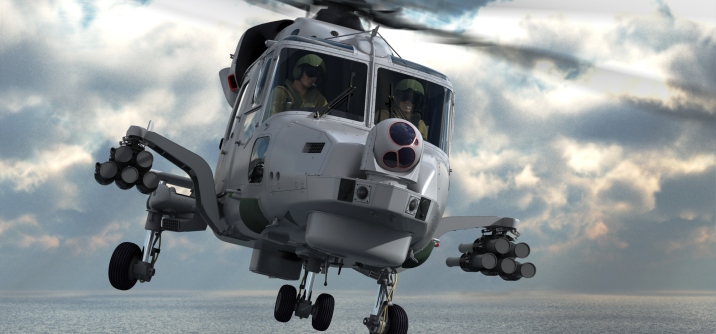Unmanned and Autonomous Systems in the Naval Environment
The aim of this blog article is to take a holistic look at unmanned systems in the maritime environment. This will not be a summary of systems already in existence and in development, but instead is intended to be an operator’s perspective on those features and capabilities that have promise, and a look at the limitations inherent in many of the systems already under development.
We are well into the beginning of the unmanned revolution in the air and at sea, with some areas more advanced than others. Unmanned systems relevant to the maritime, in particular maritime military applications, include fixed- and rotary-wing aircraft (including tilt-rotors and quadcopters), lighter-than-air vehicles, surface vessels (of varying sizes) and submersible craft. They include remotely-piloted systems as well as truly autonomous systems, the latter being an area of particular development and representing the more advanced end of the development spectrum (try this if you have not seen it already). All of these platforms share the same sensor capabilities as manned platforms, but often lead the way in miniaturised and compact systems such as radars and electro-optical (EO) sensors. They also require some form of automated sense and avoid technology, most relevant in the air but becoming more prevalent in the surface environment, and both have legal hurdles to overcome before they can operate within controlled airspace and on the high seas. Much of this is being led by civilian development, both maritime and aerial, and it is a key feature that military systems must be able to operate in a busy civilian environment; you cannot guarantee complete control of your chosen environment.
I am not going to look at unmanned mine-countermeasure systems; there is plenty of excellent material out there already (start, as always, with the most excellent Think Defence), and unmanned MCM is heading in the right direction already in the RN with REMUS and ARCIMS/MASTT. In fact there are lessons from the MCM world that could, and should, be applied to other environments as well – I hope to bring these out indirectly.
However, the field extends beyond just the platforms and the sensors to include the controlling systems and the increasing role of Artificial Intelligence. I will pen my thoughts briefly on how I think we should be best exploiting these concepts as they offer considerable advantages for unmanned systems, as well as drawbacks.
Unmanned ≠ Magic
A general point regarding unmanned systems is that you can usually, but not always rely on an unmanned system being less expensive than a manned equivalent. However, you also therefore tend to get less capability in one platform than what a complex multi-role warship or aircraft can deliver. It’s fair to say that if you add up sufficient unmanned platforms to equal the capability of a complex platform you’re unlikely to save much money, and equally unmanned systems as ‘bolt-on’ capabilities to existing platforms will also raise the cost, perhaps more than an organic system fitted to the ship. My point is, unmanned does not necessarily equal cheap.
More importantly, unmanned does not negate the laws of physics. The manned component of an aircraft is reasonably estimated at around 20% of the weight/volume (cockpit, human-machine interface, life support, ejector seat, etc), so becoming unmanned does not liberate an order of magnitude greater endurance or capacity. It’s more difficult to define in ships and submarines, but the gain is not likely to be any greater – hull forms are often defined by propulsion spaces, buoyancy and elevation of radars rather than accommodation. We are often quoted heady visions of unmanned drones scouring the seas for enemy submarines, or fear the same, whereas in reality an unmanned system will still need the powerplant, control systems, buoyancy/aerodynamics, etc to actually function. That means big, it means complex and it means costly – at best, your unmanned submarine hunter is going to be slow if it is to have any endurance. So given the marginal savings realised by trying to replicate complex, manned platforms in an unmanned fashion, plus their reduced flexibility, and I hope you concur that unmanned is not magic.
The USMC has advanced far further than the RN in unmanned aircraft, and is trying to devise an unmanned combat drone capable of VTOL operations, the MUX (see here and here). They have already considered the value of both the small UAV and the tactical quadcopter, and are looking to create a larger, long-ranged UAV that can act alongside the F35 and MV22 (and it’s Future Vertical Lift successor). To do that, they are creating from scratch a complex, armed, long-ranged, long endurance unmanned VTOL aircraft. That is neither cheap nor, for the UK, affordable – we must be wary of chasing the US when we have a far smaller budget and different capabilities that can already deliver what we need in the operational space we are able to define.
Despite the impressive range of projects and trials that are out there, I sense there is too much time being spent staring into the crystal ball, forever looking to the next evolution of technology for answers instead of exploiting what we have today. My view is that we should be normalising unmanned system operations now, even with less capable systems, so that we can start to generate the experience in our people, and therefore the ideas, that will evolve the concept far faster than industry navel-gazing.
Maritime Unmanned Air Vehicles

Rediscovering old concepts.
One of the rather delightful advantages of the current crop of maritime UAVs is the ability to break the traditional problem of launching and recovering aircraft at sea. Ever since the first aircraft flew we have tried to bring them into naval service. However, the weight of a useful manned aircraft (an evolving definition as technology progressed) almost immediately required a long runway to deploy it effectively. We found some way around this problem by developing first the helicopter, then the VTOL aircraft, to use smaller deck spaces for launch. However, none of these have the range and speed advantage that simple fixed wing aircraft enjoy.
Scan Eagle, amongst other UAVs, broke this problem set by introducing a launch and recovery system that does not require a large deck. The ability to fit catapult launchers and various recovery systems to small ships gives us a huge potential for small, potentially stealthy short- to medium-endurance UAVs with a host of possible uses. These smaller vehicles can still generate useful endurance times (with 18 hours quoted for Scan Eagle 3 and 24h for Integrator) and can carry one of the most useful, and yet widely ignored sensors available – a simple camera.
I think we underestimate the utility of a small sensor package in the maritime environment. Consider a warship operating at sea, with a surface search radar scanning out to 30 or 40 miles, perhaps further. With a simple UAV it can, at a stroke, visually identify and geo-locate every radar contact within range, something that today can only be done with a helicopter (with short endurance) or a supporting fixed wing aircraft. In the ever more challenging and contested littoral maritime environment getting positive identification of potential threats is essential; what’s more, a small UAV can operate passively, without revealing itself, and by adding stealth to the design the utility of these small platforms grows yet further. It can also clear the flightpath of any potential anti-ship missile strike, reducing the risk of collateral damage and boosting the likelihood of a successful attack.
Closer in, a small UAV gives you ideal visual coverage of incidents such as boarding operations; with a good quality sensor and a low flight altitude, it can offer excellent surveillance of a target of interest, both during the intercept phase and the actual stop-and-search. A quadcopter could do it, but it’s both short-ranged and low endurance and also a rather specific capability with little wider utility in the maritime – however, as the USMC have demonstrated a tactical quadcopter is useful in ground operations such as amphibious landings. A fixed wing UAV you gain the majority of the usefulness of a manned helicopter, with far greater endurance in both time, range and operator hours.
The small UAV adds further value when you increase the payload, although you quickly hit the limits of a small airframe (weight and power) and the catapult launch/recovery system, as well as demolish your endurance. Small radars are being trialled which undoubtably will be less capable than those on manned platforms, but the low cost per platform added to the endurance is a significant factor – the Leonardo Osprey lightweight distributed AESA is a good example. A simple laser designator immediately enables long ranged engagements using passive weapons systems; I have always thought that a UAV could be part of a long-ranged gunnery engagement with guided rounds, not just in terms of support to land forces but also in a purely naval engagement. You also have options for radio payloads to extend line-of-sight communications, and potentially even small short-term jammers.
The small UAV has further utility in the maritime-land interface, the littoral, where it can operate in support of amphibious operations by providing ISR in and around the beach-head. It will be unlikely to have the endurance of a vehicle as large as Reaper, and of course is not armed, but geo-locating enemy positions allows ships with long-ranged weapons, especially naval gunfire support, to reach in and destroy enemy positions ahead of an attack. It could also operate in conjunction with maritime attack helicopters (Wildcat and AAC Apache) to improve their ability to support the landing force, and provide additional force protection the landing craft as they operate in the shallows.

Could this still be a relevant concept?
Where the small UAV suffers is when we try to demand too much from the small platform. Weapons and higher-powered sensors demand a larger airframe which will most likely exceed the capacity of a small ship to launch and recover – the gap between a small-ship catapult/trap and a carrier with the same. As I covered earlier, unmanned does not equal breaking the laws of physics; we have traditional big-deck aircraft carriers for good reason. If we intend to attack targets remotely I think it better to retain the control of weapons by a human-in-the-loop, either from carrier-launched aircraft or else by means of long-ranged weapons such as naval gunfire support, maritime attack helicopters, NSM/JSM, TLAM or future solutions (potentially a marinised SPEAR 3). If you want to loft heavy sensor packages for long periods, be that radar, EW, jamming, sonobuoys, etc, you need a bigger deck to launch the carrier aircraft cost-effectively. Maybe there is a role for a small cat-and-trap equipped drone carrier – remember the UXV concept (see above)? We know that small EM catapult systems like EMCAT exist and could support such a concept, with netted barrier recovery as a potential recovery option. But that demands a whole new field of aircraft and ships to be developed – not a cost-effective solution today.

Could this, or its successors, be launched from a carrier?
The final option worth throwing out there in the maritime UAV field is the HAPS (high-altitude pseudo satellite). The Airbus Zephyr is a capability being acquired by the UK MOD – this article provides a good overview of other programmes as well as the concept. I would like to understand whether such a system could be carried and launched by an aircraft carrier. If it’s possible, then you have the ability to deploy an enduring communications and/or surveillance node in support of enduring operations; recovery may be a different story, however, and it may just be easier to launch from a known airfield and deploy it slowly over a few days. There is similar potential in inflatable and dirigible systems. The issue here, however, is persistence – a moored or tethered system would be a huge constraint on a ship’s ability to manoeuvre, operate in heavy weather or operate aircraft (crashing into mooring wires, etc). A dirigible system able to manoeuvre and use long-endurance propulsion systems (like Zephyr) would be worth investigating.
Unmanned Capabilities for Anti Submarine Warfare

Nuclear ASW – well, one way of doing it.
UAVs have pretty broad potential in the anti-surface warfare and surface surveillance environment, but underwater the challenge is very different. To hunt a submarine, which is the Royal Navy’s core fighting capability, there are many options to do so ranging from the seabed sensor network of the Cold War, SOSUS, through to towed array frigates, maritime patrol aircraft, friendly SSNs and helicopters deploying sonobuoys and dipping sonars. But before I dive into this rich field, I want to recap the limitations of the environment, and once again reinforce the difference between nuclear ASW and conventional ASW (not as depicted above!).
Nuclear ASW, the challenge of hunting the nuclear-powered submarine, is very different to hunting the conventional submarine, though I accept that the difference is becoming slightly (very slightly) less clear with some of the new generation AIP SSKs. Nuclear submarines are costly, expensive and capable machines; consequently, they need freedom to manoeuvre and are best suited to open ocean warfare. Their sensor suite is optimised to find very quiet targets in large bodies of water, and the nature of their propulsion makes them noisier than their conventional counterparts. SSKs on the other hand, when not operating noisy diesels or other engines, are virtually silent and cannot be located the same way. They are shorter ranged and slower, thus better suited to shallow and coastal waters, and have smaller crews and less capable sonar suites. The close littoral environment where they operate is, however, extremely noisy – fishing fleets, merchant traffic, oilfields, etc – and complex – with layers caused by heat buildup and other interactions. All this makes acoustic warfare much more challenging, so they rely more on operating at shallow depths, using periscopes and other non-acoustic detection means to locate surface ships for attack. Thus nuclear and conventional ASW are two very different challenges, not easily dealt with by a single tool-set. The division is, for the moment, still reasonably clear – track the nuclear threat passively, and hunt the conventional threat using active sensors, primarily sonar but also radar.
I’ve looked at the ASW problem before (see here), and discussed the utility of unmanned submersibles to provide wide area understanding of the water column and background noise, a vital tool in the antisubmarine battle. These have utility in both nuclear and conventional, open-ocean and littoral ASW, and exist already in a number of forms not least of which are those under development by CMRE. They are virtually invulnerable, as not only are they quiet but are also almost impossible to attack. But these are not really detection assets – they are too small to have the speed and endurance to be useful tactically; recovering them in any sea state is difficult because of their cylindrical, unstable hull form; and they suffer the same problem as all underwater assets – how to communicate in real-time with surface and aerial assets in a coordinated search. Moreover, they are too small to carry weapons systems and too slow to be able to attack themselves. But as persistent environmental analysis tools, and potentially as passive sensors, they are well placed.
The most potent tool for any type of ASW is the maritime patrol aircraft, and there is some utility is developing sensor-equipped ‘loyal wingman’ support aircraft to extend the radar and sonar coverage of these aircraft. The MPA will still, I think, be an enduring requirement as the command and control node, because the unmanned system will be limited in the about of data processing and classification it can accomplish alone. Moreover, as the MPA becomes an ever more costly asset to deploy there is logic in offsetting the cost through the ‘loyal wingman’ idea to extend the coverage. Of course, this is likely to be a land-based asset; developing the carrier-launched equivalent will not be easy, especially when you do not have a catapult-equipped carrier.
However, the MPA is limited in its ability to persistently conduct wide-area search (and in doing so gets through a huge quantity of expendable sensors such as sonobuoys), and so the surface ship is still a key element of all-arms ASW. As the cost of frigates and destroyers spirals ever upwards, the unmanned component can extend the range of individual platforms by deploying active or passive sensors at range. A surface vessel can use air-breathing propulsion systems that offer greater range, speed and endurance than submersible craft, and can be designed to operate in heavy weather – one advantage of unmanned is that you can keep working when it is roughers without losing crew effectiveness (so no more Able Seamen operating a sonar whilst vomiting in a bin bag!). Again I looked at one example before, the Elbit Seagull, and there are other options out there. The unmanned surface asset can be recovered and resupplied more easily (owing to the optimised surface hull form and existing launch/recovery systems), and can more easily maintain the vital data link via radio that allows it to be an effective force multiplier. They are more vulnerable in some cases, especially in the littoral environment, but you only have to look at South American drug cartels to know that making surface craft difficult to locate is certainly possible.

A model for an unmanned surface ASW asset?
Unmanned in the Surface Battle
It’s more difficult to see a role for the unmanned surface vessel in the anti-surface environment, not least because this generally demands airborne assets to locate, and ship-launched weapons to prosecute. Moreover, small vessels such as these are challenging to manoeuvre and control their engagements when close in to the mother ship, and can only carry a limited number of weapons. The opportunity is probably solely in the provision of additional launch platforms to support counter-swarm tactics, where a ship can be faced down by dozens of small, lethal craft, whether manned or unmanned themselves.
A future ship-borne counter-swarm capability?
We have a pretty good capability already in the gun and missile-armed maritime attack helicopter, so it is possible to consider adding unmanned rotary wing platforms as weapon carriers. There is a close crossover between those and the small fixed-wing UAV I favour as a high priority for ships today, but the trade-off here is endurance and speed for payload, which is more appropriate in the close surface battle. A decent maritime attack helicopter, teamed with a short-medium endurance fixed-wing UAV for surveillance and a number of smaller weapons platforms, represents a step-change in being able to deal with a swarm of small vessels when the threat is real, and shore support is lacking. Adding the surveillance and firepower capability of the ship only improves the package further and significantly increases the lethality of the surface combatant. A missile-armed surface combatant is a possibility, but I think the command and control of it would be challenging, and it would be simpler to mount additional weapons on the ship which is a far more stable firing platform.
The vulnerability of Unmanned Systems
Everyone in the defence commentariat seems to assume that communications just happen. The truth is that comms are far more challenging and vital than is widely appreciated. Even with modern communications systems, you have to ensure that all stations are on the right frequency using the right encryption at the right time. You need to ensure that there is no interference, that your aerial is pointing the right way and that the frequency you are using is correctly offset (usually for HF). Satellite communications are restricted by bandwidth and atmospheric interference. It takes a lot of effort by human operators to ensure your communications network is set up, stable and correct.
An unmanned system is vulnerable to a loss of communications, because it has a limited ability to engineer its way out of the problem and the burden of that comms engineering always falls on the manned end. You don’t need to break an encryption key to disable communications – just jam the frequency. And unmanned systems are more likely to transmit high-bandwidth data than low-bandwidth – video streaming, radar data, etc. – so a lot of bandwidth is going to attract a lot of attention. There are technical solutions to all of these problems, but it means upgrading your radio systems accordingly and that, especially in aircraft, can be eye-wateringly expensive.
If you break the link between an unmanned system and its controller, what happens? Does the system abort and RTB, thus potentially revealing your location? Or does it carry on and deliver it’s mission – difficult if you are relying on it to deliver live data. This problem set needs to be addressed in the early stages of the system design, and made easy to interact with and manage by the intended operator.
Artificial Intelligence
I am no expert in AI but I do understand that it is an evolution of current computing that allows a system to become adaptable and to evolve to be able to make complex decisions and process data in multiple ways. This offers obvious advantages, not least in potentially overcoming the communications vulnerability issue and lost-comms options that affect unmanned (and manned) systems. But it also allows you to potentially offload some of the data processing back to the unmanned system, where today we rely on accurate human decision-making and experience.
AI should be seen as a way to enhance current processes but not replace them, to enhance a surveillance system not replace the human operator – or the QM on the gangway. If we ever get around to investing in a comprehensive full-spectrum electro-optical surveillance system on our ships (think an equivalent to the F35’s distributed EOSS), then an AI subroutine could scan the visual data looking to achieve combat identification or threat recognition. It could model with greater accuracy the best response to an incoming missile threat, or analyse the pattern of movement in a swarm to identify the controlling nodes, and in electro-magnetic and cyber warfare it has obvious utility. Essentially, AI can deliver an element of sensor and systems fusion that we currently cannot achieve with human operators, notwithstanding the excellence of our people, our training and our combat systems.
Conclusion

Unmanned – not inhuman.
If there is a theme to all of my rambling, it is that unmanned systems should be viewed as a force multiplier not a revolutionary new capability. We should also be doing more with what we have, to start deriving experience in our people not continue gazing hopefully into the crystal ball. The idea of a loyal wingman or distributed sensor node is appropriate, always with the manned capability in the centre, but equally making the point that an unmanned system should not necessarily be a complex, costly replacement for a manned equivalent. Scan Eagle/Integrator and the Elbit Seagull are the two examples I see as offering the best short-term, low-cost way into using these systems more widely, and we can develop plenty more from there. We should avoid trying to re-invent the Reaper/Predator-sized MALE systems just because it worked over Afghanistan – they are big, complex, costly and vulnerable. Unmanned systems can significantly enhance the effectiveness of a single unit’s sensors without extortionate cost, remain disposable and should be developed more quickly, using more off-the-shelf options, and should feature in more future capability development projects than we currently see.
I will finish with a legal question that came up in my considerations. Could an armed, unmanned system defend itself from a manned threat? Right now, I’m not sure it could – when do we give machines the right to self defence?



“The USMC is trying to devise an unmanned drone capable of VTOL operations, the MUX. The issue is not creating an unmanned system, but actually overcoming more conventional problems of launching and recovery from ships. There is no sudden capability realised by it being unmanned,” <- Agreed, but while Unmanned systems are not magic, they can use MAGIC. https://news.usni.org/2016/06/30/navys-magic-carpet-simplifies-carrier-landings-interim-fielding-fall
Very good points on UAV comms vulnerabilities.
"when do we give machines the right to self defence?" – I don't think we do, I think we have a human in the loop at all times to authorize weapons release literally by the pressing of a button for a single missile launch like a Hellfire or Mk46 or, for a rocket salvo, gun strafing run, or dogfight, holding of a button for the duration of the action the weapons are to remain free.
Great article about the complexities and limitations of Unmanned Operations that, I would venture, most don't realize exist.
LikeLike
Excellent article TAS. You are right in pointing out that unmanned is not always cheaper or necessarily requires any less people that historic systems. I think we should view unmanned systems as more a case of separating the sensor from the operator. This allows us to send the sensor into areas where it would be very high risk to send humans (Minefield, recon something that can shoot back). It also allows us to recon areas for much longer and collect much more data. Double edged sword as this usually requires more crews to operate it and more analysists to pour over the info collected.
This one would hope allows the platforms or the bases where the human operators are to be less specialised and to an extent less people fwd deployed in harms way.
Systems like MALD-J, alarm, or indeed fire shadow are I think weapons that can return more into thinking going fwd. something that is cheap which we can launch for several hours and attack something with, perhaps doing something similar with a torpeado maybe useful in future too.
LikeLike
“Could an armed, unmanned system defend itself from a manned threat?”
If you put Phalanx into AUTO is this not what it does 🙂
LikeLike
I think you misunderstand – the question might be better in the context of a manned vs. unmanned aerial engagement. Would an unmanned, autonomous system have the ROE to shoot down a manned fighter? Self defence does not apply to property, at least not under UK law.
Maybe a slightly trick question, but there will be new legal ramifications of this technology as autonomy and AI develop. That’s what I was aiming to bring out.
LikeLike